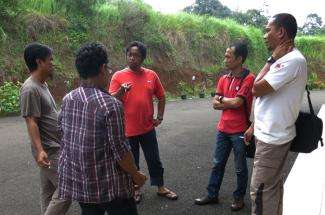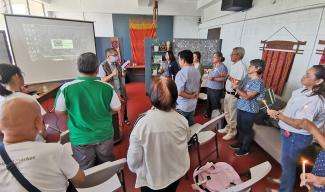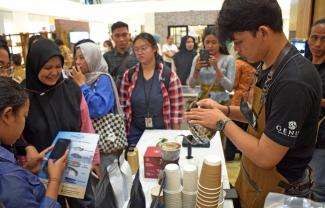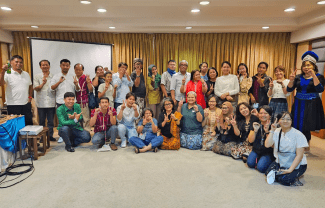2015 is the last year for Samdhana to realize its support commitment for partners in Sumatra with regard to community preparedness for REDD Schemes. For three days (22-24 January 2015), the Sumatra-based partners were gathering in Bogor to share how they were performing, what hampered their work and what they achieved throughout 2014. They also developed a plan for conservation of Sumatra's forest resource for the following year.
The program Community Preparedness for the REDD Scheme for Sumatra-based partners works through three learning nodes: campaign, regaining of community forests, and safeguard and policies. This year is the third year of Phase-2 to implement the program with support from NORAD.
Budi Rahardjo, Samdhana's Program Director, reminded the participants of the logframe previously developed. There were three (3) outcomes the discussion focused on: first, effective engagement of civil society and local communities with government agencies to ensure that land use change planning and large scale plantation licensing avoid or reduce carbon emissions through approaches that are acceptable to local communities; second, effective engagement of civil society and local communities with forestry and plantation license holders to ensure that plans to reduce carbon emissions include agreements with affected communities on the use of community lands; and third, communities' secure rights over and management of their landscapes to reduce carbon emissions. The discussion went on dicussing which activities to be further continued to achieve the agreed objectives. That the objectives might not be all achieved if the dynamics on the ground do not permit became the concern of all. The Sumatra Strategies (the logframe and work plan) of each of the learning nodes were reviewed for the 2015 implementation.
“There are so many activities but, given the dynamics on the ground, I think they could be changed. Therefore, I expect to meet - take the third outcome, which communities have had secure rights and been able to manage. Where do they live? How many? Where? If they exist, shall we increase their capacity or continue with new communities,†said Budi.
Through Samdhana's 3-year support, what the partners have achieved through the learning nodes can expectedly be maintained and improved on the pre-defined scale of change. The partners' achievements and project implementation were evaluated against the change framework that had been elaborated in the work plan of each learning node. The work plan was jointly formulated in July 2013 in “GG Houseâ€, Puncak Bogor, and was further improved in the partner meeting in Pekanbaru in 2014.
The meeting, facilitated by Arif Wicaksono, Christian ‘Bob' Purba and Khalid Syaifulah, included a critical analysis based on the documentation and record of the experience sharing among Samdhana's partners in the implementation of the REDD Preparedness.
Further, the participants developed a joint follow-up agenda for the period after NORAD's second 3-year support. The agenda contains further work to promote the safeguard framework, ensure recognition of and respect for the rights of local communities (local and indigenous), and minimize social and ecological impacts of investment in Sumatra region.
“Developing a plan that we have been discussing about in the last 3 years, how we contribute to the preservation of Sumatra's forests. We have known many good suggestions and initiatives. Hopefully, this meeting can reflect what we have achieved,†added Bob Purba of Forest Wacth Indonesia (FWI).
The participants of the meeting were Samdhana's partners in Sumatra, namely Walhi Sumbar, Walhi Riau, Walhi Sumsel, Walhi Jambi, Walhi Bengkulu, Walhi Lampung, Walhi Sumut, YKWS Lampung, YRBI lampung, Watala Lampung, TPP Lampung, Kawan Tani Lampung, Qbar Padang, Yamitra Lampung, Jikalahari Riau, YMI Riau, WBH Palembang, Akar Bengkulu, AMAN Jambi, AMAN Bengkulu, AMAN InHu, AMAN Tano Batak and AMAN Sumut. Also present in the meeting were JKPP, FWI and PB AMAN.




